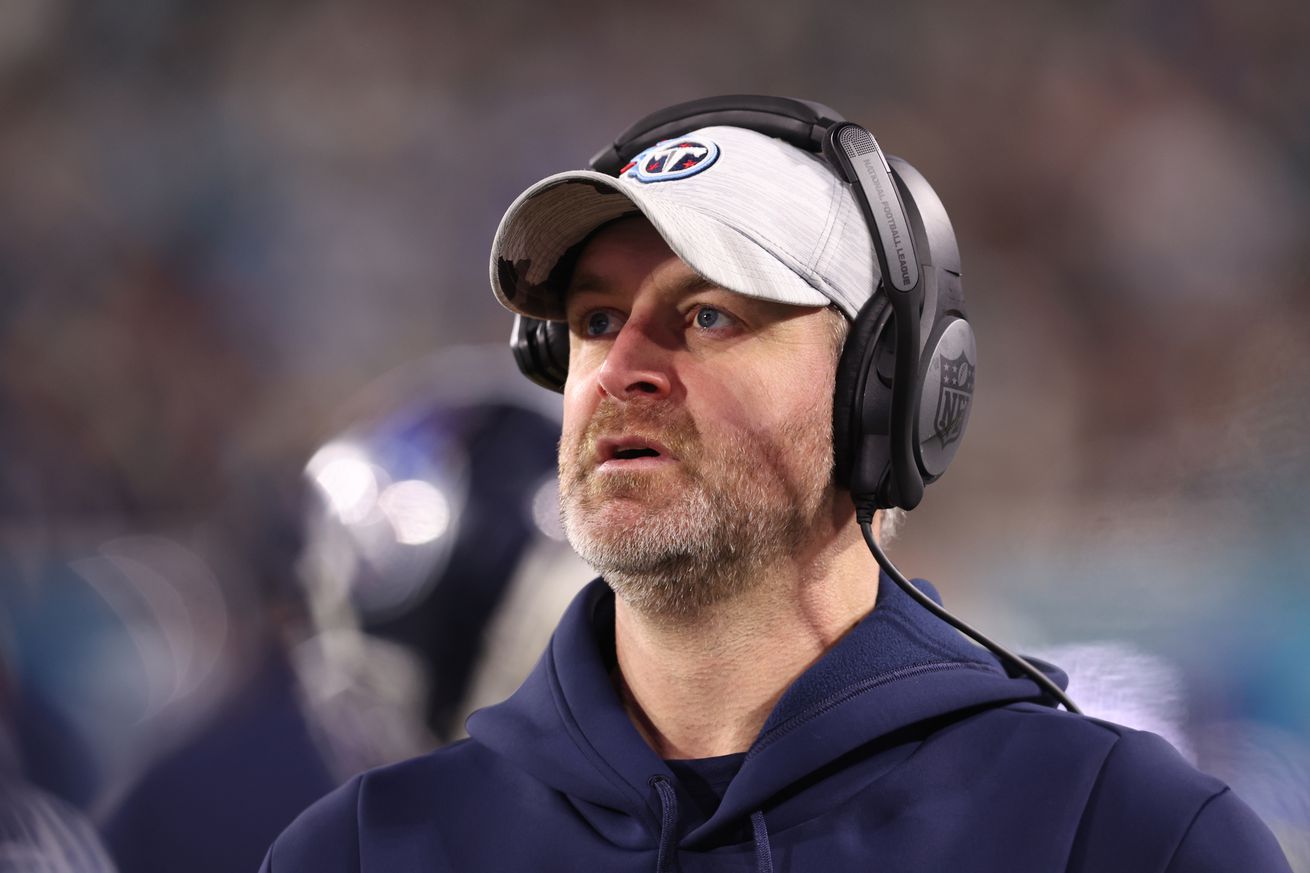
Part 2 of our look at what new defensive coordinator Shane Bowen brings to the Giants
The New York Giants added young defensive coordinator Shane Bowen, who had that job for the Tennessee Titans the past three seasons, to their staff on Monday. We detailed differences between his defense and former Giants’ defensive coordinator Wink Martindale in the first edition of The Bowen Breakdown. Now, we’re turning our attention to the Titans’ red zone defense.
The Titans were a stout defense against the run in all three years under Bowen’s watch. They were also the most effective defense in the red zone last season. Tennessee allowed a touchdown on 37.7% of red zone trips; second place in that category was the Baltimore Ravens, with a 42.3% rate.
Tennessee ranked 14th in 2022, allowing a touchdown on 55% of red zone trips, and they ranked fourth in 2021 – Bowen’s first year as coordinator – with a touchdown rate of 51.67%.
‘Bend, don’t break’ was a way to describe Patrick Graham’s defense, and Bowen’s unit could be described in that manner as well, although the schemes were different.
Bend, don’t break
The Jaguars had first-and-goal at the 7-yard line down 28-20 in the fourth quarter in Week 18. Bowen’s unit rolled out in a Nickle 2-4-5 against a 3×1 set with the running back to the lone tight end side, which was the short-side of the field.
/cdn.vox-cdn.com/uploads/chorus_asset/file/25273417/Screenshot_2024_02_07_at_8.12.50_PM.png)
Tennessee had a four-over-three advantage to the three-receiver side, with man on the tight end side. The strong safety-oriented to the three-receiver side to assume crossing routes. The cornerback against Calvin Ridley (0) is in MEG (man everywhere he goes) with inside leverage. The apex defender read three to two with Zay Jones (7) motion, and would have reacted downhill if Jones was three to the flat.
The safety to the three-receiver side read two to three and played the goal line while reading Trevor Lawrence (16). The inside backer related to Jones (the three) and assumed inside leverage due to his positioning and the safety of those who were on the goal line. Both safeties on the play act as middle hook defenders and safety areas for their fellow teammates who are essentially in man coverage, which is basically match.
Some hear match coverage and may not understand what that means. Pattern-match is “zone” until the receiver’s routes are declared, and then it turns into man coverage. This is a universal concept, and each defense has its own rules against certain offensive looks. The numbers in the above illustration relate to the receiver’s presnap position:
No. 1 = outermost receiver (Ridley)
No. 2 = middle receiver on the three-receiver side (Washington, No. 11)
No. 3 = Innermost receiver (Jones)
The following play after the incomplete pass to Ridley was a pass to Jones that placed the ball at the 1-yard line on third down:
Jacksonville aligned with an extra offensive lineman, three tight ends, and running back Travis Etienne (1). The play was designed to Etienne off the sprint-out. The defense adjusted to Brenton Strange’s (85) motion that widened Mike Brown (44), who was initially covered by Azeez Al-Shaair. Strange tried to rub Al-Shaair in the hopes that Brown would go with Strange, giving Etienne leverage outside where. Brown diagnoses the play and sticks to Etienne. Elijah Molden (24) blankets Luke Farrell (89) on a corner route.
/cdn.vox-cdn.com/uploads/chorus_asset/file/25273720/Screenshot_2024_02_07_at_10.44.56_PM.png)
Defenders in pursuit surrounded Strange. Harold Landry III (58) pressed through the outside shoulder of the folding lineman to flush Lawrence and force a fourth-and-goal at the 1-yard line.
Bowen’s defense stepped up to shut down Lawrence’s QB sneak on fourth down, which helped the Titans pull off the upset that kept Jacksonville out of the playoffs. Low-man wins; former Dallas Cowboys Quinton Bohanna (97) and Keondre Coburn (91) proved that on the play above.
Amani Hooker (37) should have secured this Joe Burrow interception in the Titans’ 27-3 upset victory over Cincinnati in Week 4. The Bengals were in EMPTY with both safeties reading and reacting to inside-breaking routes; both safeties were in position to stop the Bengals’ efforts:
/cdn.vox-cdn.com/uploads/chorus_asset/file/25273738/Screenshot_2024_02_07_at_11.00.56_PM.png)
To the three-wide receiver side, the Bengals used Ja’Marr Chase (1) and Tyler Boyd (83) to pick and clear out the delayed slant by Trenton Irwin (16). Bowen’s usage of the safeties along with corners playing inward with proper leverage allows the safeties to use their eyes and read, react, and attack. There are vulnerabilities to this style of defense, which we’ll go through later, but this alleviates issues in the middle of the field down in the red zone.
After missing two deep shots to the back corner of the end zone, Geno Smith and the Seahawks attempted to utilize the size and strength of DK Metcalf (14), who met resistance against Terrell Edmunds.
/cdn.vox-cdn.com/uploads/chorus_asset/file/25273751/Screenshot_2024_02_07_at_11.12.30_PM.png)
Metcalf flattened the initial part of his route to sell the drag route; Edmunds’ angle down was conservative enough to impede Metcalf’s subsequent move, which was designed to explode through the two reading safeties and into a void. Smith attempted to put the football high to allow Metcalf to use his size, but Edmunds did a great job defending the receiver to force a field goal.
This type of defense is common in the red zone. Two-read coverage is something used often by Bowen between the 20s as well, with different rules, of course, but crowding the middle of the field with two safeties who use their eyes well allows the defense to clog up inside breaking routes, and provides an advantage against the run, as well as rushing quarterbacks.
Side note for future discussion – Xavier McKinney would do very well with this style of defense.
Curveballs vs. certain QBs
Get Dexy into coverage
Hopefully, not often, but Bowen did incorporate his defensive linemen as a QB spy/middle hook that gave the defense a three-man WIDE rush to confuse and/or entice the quarterback to rush into a crowded area. I noticed this more on tape against non-elite quarterbacks like Anthony Richardson, Gardner Minshew, and Case Keenum.
Keenum attempted to hit the post in the back of the end zone that was undercut by the MIKE, but the underneath slant came open in front of the linebacker. It appears like one of the three defenders around the offense’s right hash may have shaded too far toward that side:
/cdn.vox-cdn.com/uploads/chorus_asset/file/25271299/Screenshot_2024_02_06_at_8.26.11_PM.png)
It’s plausible that Keenum was thrown off by the drop-eight tactic utilized by Bowen on this second-and-1 play.
Bowen attempted to run this same look against Keenum later in the game, where the quarterback did a great job of drawing two defenders toward the line of scrimmage – via the threat of running – which allowed Noah Brown (85) to break away from his assignment to the voided area of the condensed field.
On this first-and-10 in Week 5 against the athletic Colts’ young quarterback Anthony Richardson, Bowen seemed to task Jeffrey Simmons with a controlled rush. Indianapolis was in EMPTY and ran Zack Moss (21) as a fast four to the three-receiver side with the objective of shifting the second-level defenders to open a rushing lane for Richardson. Al-Shaair (2) bumped Jack Gibbons (50) before the snap to even the math to the field side with a very light box at the snap:
/cdn.vox-cdn.com/uploads/chorus_asset/file/25273327/Screenshot_2024_02_07_at_7.01.39_PM.png)
With a rushing quarterback as a threat combined with evening up numbers to the field side, Bowen’s defense has to be wary of the light box and have cognizant players that can quickly react to multiple threats.
/cdn.vox-cdn.com/uploads/chorus_asset/file/25273338/Screenshot_2024_02_07_at_7.10.23_PM.png)
Three rushers aggressively go after Richardson, but Simmons executes a measured rush and acts as a spy. Harold Landry III (58) rushes into the B-Gap to help free Simmons up to the outside, which also creates the illusion that Richardson has space outside, but Al-Shaair tempers his pursuit of Moss and keeps his eyes on Richardson to ensure he doesn’t attack the lightbox.
The rookie attempted to rush, and he only gained 1 yard as Al-Shaair and Simmons, as well as Kevin Byard (31), quickly threw him to the deck. There are only 11 players on defense; if a coordinator can have competent players execute multiple assignments to combat different threats, that’s a win for the defense.
Blitz them!
On the very next play, a second-and-9, Bowen dialed up a five-man double corner blitz with Simmons dropping off his rush and spying Richardson. Bowen was not going to allow Richardson to win with his legs. He had two rushes for 5 yards in the game. He had 23 rushes for 131 yards and four touchdowns in the previous four weeks.
/cdn.vox-cdn.com/uploads/chorus_asset/file/25273357/Screenshot_2024_02_07_at_7.30.24_PM.png)
The Colts had a tight end screen dialed up, but the blitz got home, and Indianapolis lost 17 yards on the play. Bowen’s blitz rate did not deviate much in the red zone, although he blitzed the Colts and Texans more than other teams I saw:
The Titans came out in an ODD Under front (3T to the weak side) and rushed all five defenders that were on the line of scrimmage. I wanted to highlight this play, specifically, because there are multiple pass-offs between defenders, with the second-level defenders keeping their eyes on Stroud. This gave the rushers more freedom to attack and not have to contain.
Eric Saubert (81) was briefly open, but the red zone communication was on lockdown. Otis Reese IV (41) was playing in his second career game and did not handle that specific pass-off well. Even though Stroud had almost seven seconds to throw, there were few options. This an excellent example of how the match is supposed to work in the red zone against crossing routes.
Vulnerabilities
Tennessee only allowed 10 rushing touchdowns in 2023, which ranked tied for fifth-best in the NFL. This is more impressive since the Titans’ offense finished 27th in the league in scoring, meaning their team was theoretically trailing later in games, giving the opponent offense more opportunities to score on the ground.
The Titans only allowed 20 receiving touchdowns, 12 of which came from the red zone. Stacks, motion, and switch releases led to two well-devised touchdowns against the Colts (Michael Pittman Jr.) and Steelers (Diontae Johnson).
Other receiving touchdowns were the result of well-improvised plays by Lamar Jackson and Case Keenum (to Zay Flowers and Noah Brown). Houston’s Brevin Jordon had a play-action slide touchdown, too. There was also a Cover-3 touchdown for Calvin Ridley of Jacksonville, where the cornerback was held in the flat too long.
One area of the field that the opposing offense attempted to attack in the red zone was the deep corner route, typically with a smash type of concept or a double move to gain leverage and isolate a one-on-one matchup away from the two defenders hanging around the hash.
Evan Engram (17) ran an out-and-up behind a dig route from a stack that was beautifully designed by Doug Pederson and the Jaguars. Similar to Patrick Graham, Bowen aligned in off-leverage often; he may be a coordinator who gives his personnel freedom, but the defense was not frequently in press down in the red area.
The goal of the dig route was to clear out the outside defender to allow Engram to work out and up against a defender to the inside:
/cdn.vox-cdn.com/uploads/chorus_asset/file/25271156/Screenshot_2024_02_06_at_6.43.21_PM.png)
Once the outside defender opened to the inside, natural traffic was created for the apex defender to work toward Engram, who had all the space outside the numbers; the apex defender went to plant and drive on the out, giving Engram the necessary space to explode vertically for an easy touchdown.
On the field side, defenders often aligned with an inside shade in match and two-read coverage. At the top of the screen, we see slight inside shade, off the line of scrimmage by about seven yards. Browns’ coach Kevin Stefanski recognized the alignment and the space, and understood how to manipulate it with a first-and-10 sluggo route:
/cdn.vox-cdn.com/uploads/chorus_asset/file/25271177/Screenshot_2024_02_06_at_6.53.20_PM.png)
Double moves in the red zone can be dangerous. And much like many other defenses around the league, the back corner of the end zone, away from the two safeties who are looking to assume deep responsibilities from inner receiving threats, is vulnerable if the outside cornerbacks can be influenced inside or toward the line of scrimmage.
Against Geno Smith and the Seahawks, the former Giant quarterback attempted eight deep corner passes from the red zone alone. They connected on one, which was a beautifully placed pass to Metcalf:
That’s a very small window that needed a great throw for success. I’m fine with opposing offenses taking 50-50 fade shots in the red zone insofar as the Giants find an outside cornerback opposite of Deonte Banks.
Ridley caught this touchdown against Bowen’s defense on a smash concept from a stacked alignment. The outside cornerback will take the first receiver to the flat, which isolates Ridely against the apex defender, who is slightly to the inside. Christian Kirk (13) kept the cornerback at the goal line, and Ridley ran into open space to the back of the end zone for a touchdown. The defense had two defenders using their eyes to match anything over the middle; this left the outside cornerbacks susceptible to outside routes but allowed the defense to spy or fit the run easier in draw situations.
Final thoughts
Bowen’s red zone defense excelled based on timely plays and great communication that forced more field goal attempts than any other team in the league. The defense relied on proper positioning and leverage with sticky coverage once the routes were declared by the offense. The leverage of the defenders was dictated by their position on the field (wide or boundary side) and by adjacent defenders.
In the red zone, the safeties often read the quarterback and looked to undercut inside-breaking routes while being aggressive against the run. His pressure rates were similar between the 20s and in the red zone, but Bowen did seem apt to bring the heat against non-elite quarterbacks. It’s tough to say if Bowen will maintain the exact same style of defense in the red zone with the Giants, but he did something correctly last season, so let’s hope it’s replicable.















You must be logged in to post a comment Login